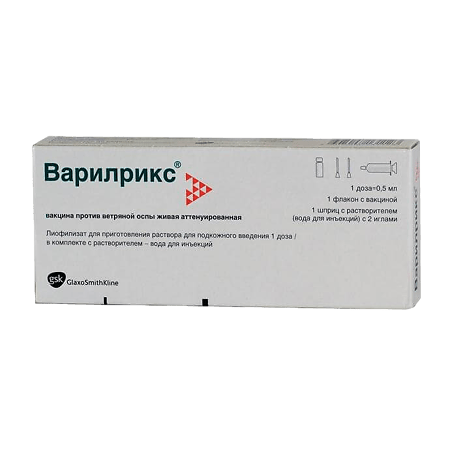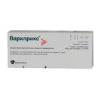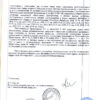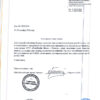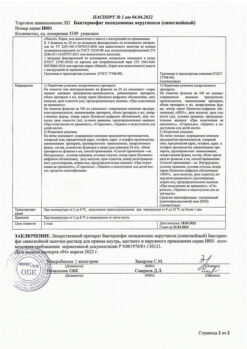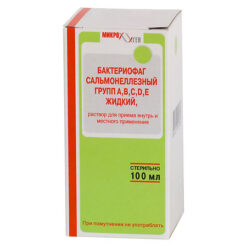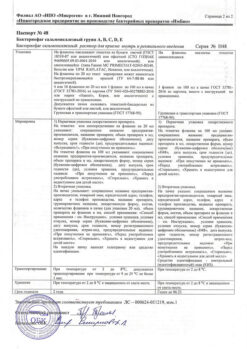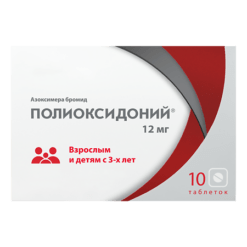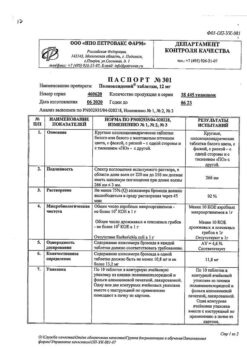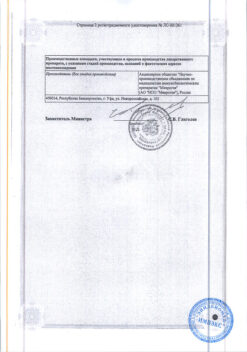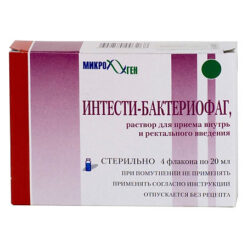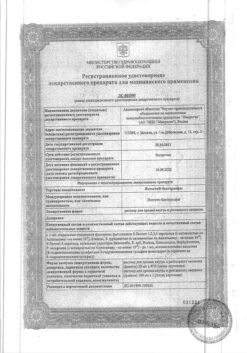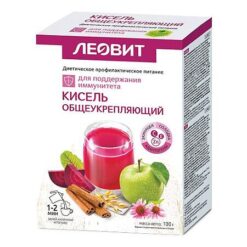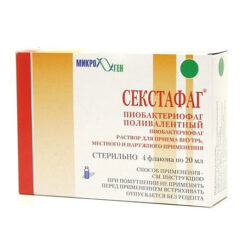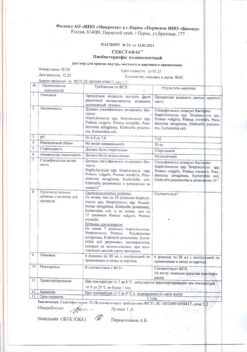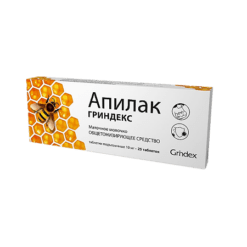No products in the cart.
Varilrix, lyophilizate 1 dose
€1.00
Out of stock
(E-mail when Stock is available)
Description
Mechanism of Action
The administration of Varilrix vaccine induces the production of antibodies to the varicella virus, providing specific protection against this infection.
Immunologic efficacy
Healthy subjects
Serconversion rates in healthy children aged 9 months to 12 years, inclusive, determined six weeks after vaccination exceeded 98% and persisted for at least 7 years after vaccination.
The seroconversion rate determined in children 13 years of age, after double vaccination, was 100% and persisted for at least one year.
In clinical studies, it has been shown that most vaccinated people who were subsequently exposed to the disease either were not infected or had a significantly milder form of the disease (fewer rashes, no fever). One study also demonstrated 100% protection against standard clinical manifestations of chickenpox and 88% protection against any manifestations of Varicella virus infection (assessed as at least one rash).
High-risk patients
Chicken pox is an important risk factor that worsens the course and prognosis of existing severe disease in the following patient groups:
- patients with acute leukemia;
- patients receiving immunosuppressant therapy, including the use of corticosteroids;
- patients scheduled for transplant surgery;
- patientsPatients with severe chronic conditions such as metabolic and endocrine disorders, chronic lung and cardiovascular disease, cystic fibrosis, and neuromuscular disorders may also be factors that worsen the prognosis for chickenpox;
- healthy people in close contact with patients or high risk groups who have not had chickenpox and have not been previously vaccinated.
Patients in the above groups who are receiving immunosuppressant therapy (including corticosteroid use) for malignant solid tumors or for severe chronic diseases (renal failure, autoimmune diseases, collagenosis, severe bronchial asthma) are prone to develop severe chickenpox.
High-risk patients have a seroconversion rate of 80% and leukemia patients have a seroconversion rate of about 90%.
In high-risk patients, periodic determination of chickenpox virus antibody titers is recommended to decide if revaccination is needed
. One study found that the incidence of varicella among patients with leukemia was lower in vaccinated patients than in unvaccinated patients who were naturally infected.
Vaccine virus transmission between immunocompromised siblings has been reported, but there was little cutaneous manifestation in the infected children.
Indications
Indications
Active ingredient
Active ingredient
Composition
Composition
Varilrix is a live attenuated chickenpox vaccine, which is a live attenuated Varicella Zoster virus (strain Oka) obtained by multiplication of the virus in human diploid cell culture MRC-5.
The specific activity is not less than 3.3 lg POU/0.5 ml.
Associates:
Human serum albumin,
Neomycin sulfate,
lactose,
sorbitol,
mannitol,
amino acids.
Solvent: water d/i – 0.5 ml.
How to take, the dosage
How to take, the dosage
Method of administration
Vaccine Varilrix® is intended for subcutaneous administration.
In order to prepare the solution for injection transfer the contents of the ampoule or syringe with the solvent into the bottle with lyophilizate, shake the resulting suspension until complete dissolution of lyophilizate (approximately 3 minutes), then put back into the syringe.
The prepared solution is clear yellow-pink to pink in color, without sediment and visible foreign substances.
Before administering the vaccine, the contents should be inspected for foreign particles and changes in appearance. If any abnormalities are found in the vaccine, the package must be destroyed. After treating the injection site with alcohol or other disinfectant, wait for this substance to evaporate, since inactivation of the vaccine virus may occur in contact with such compounds. The vaccine should be administered immediately after it has been diluted with the solvent.
Vaccination schedules
Children from 12 months to 13 years: 1 dose of the vaccine (0.5 ml) once.
Persons over 13 years of age (including contact with high-risk groups and those who are ill): 1 dose (0.5 ml) twice with an interval of 6-10 weeks between injections.
Immunization of high-risk groups
Patients with acute leukemia, patients with severe chronic diseases and patients receiving immunosuppressant therapy and radiation therapy. Immunization of such patients is carried out in a state of complete hematological remission of the underlying disease. At the same time it must be made sure that the total lymphocyte count is at least 1200/mm3 and that there are no symptoms suggestive of cell-mediated immunodeficiency.
If patients are scheduled for vaccination during the acute phase of leukemia, chemotherapy must be interrupted for one week before and one week after vaccination. Vaccination should not be performed during periods of radiation therapy.
Patients who are going to have an organ transplant
If patients are going to have an organ transplant (for example, a kidney), the vaccination should be given several weeks before immunosuppressant therapy begins.
Emergency prophylaxis
The vaccination is given once with 1 dose of vaccine (0.5 ml) within the first 96 hours after exposure (preferably within the first 72 hours).
Interaction
Interaction
Varilrix vaccine administration is possible not earlier than three months after immunoglobulin administration or after hemotransfusion.
Salicylates should be avoided for 6 weeks after Varilrix vaccination, since there have been some reports of Reye’s syndrome development on the background of infection caused by varicella zoster virus.
The vaccine can be administered simultaneously with inactivated vaccines of the national calendar of preventive vaccinations of the Russian Federation and the calendar of vaccinations for epidemic indications of the Russian Federation, except for anti-rabies vaccine.
The simultaneous administration of Varilrix vaccine with measles-mumps-parotitis vaccine or with diphtheria-tetanus-pertussis vaccine does not reduce the immune response and does not increase reactogenicity of Varilrix vaccine.br>
The measles-mumps-parotitis combination vaccine and varicella vaccine can be administered simultaneously when administered at different sites. However, if these vaccines are not administered at the same time, the interval between administering them should be at least 30 days to achieve maximum antibody levels.
The interval between vaccinations with Varilrix and vaccines other than those listed above should be at least one month. If several vaccines are administered at the same time, the contraindications for each of the vaccines used must be taken into account.
All vaccines are given with different syringes at different injection sites.
High risk patients
Varilrix should not be given at the same time as other live attenuated vaccines. In this case, other vaccines should be administered at different injection sites.
Special Instructions
Special Instructions
As with other injectable vaccines, an adrenaline injection solution should always be on hand during the administration of this vaccine in case of anaphylactic reaction. The vaccinated person should remain under the supervision of a medical professional for 30 minutes after the vaccination.
In extremely rare cases transmission of the vaccine virus has been recorded. Therefore, vaccinated persons should avoid contact with pregnant women because they are particularly susceptible to chickenpox (mainly during the first trimester of pregnancy), as well as with persons at high risk for severe chickenpox (e.g., patients with leukemia or those receiving immunosuppressant treatment). In cases where there is no way to prevent contact with those listed above, the potential risk of transmission of the vaccine virus should be weighed against the risk of contracting and transmitting the natural varicella virus.
Vaccinated patients who develop a rash within 3 weeks of vaccination should exclude all contact with pregnant women (especially during the first trimester of pregnancy) and immunocompromised conditions.
Impact on CONCENTRATION OF ATTENTION
Unlikely.
Contraindications
Contraindications
Cautions
As with parenteral administration of any vaccine, everything should be on hand to treat a possible anaphylactic reaction to Varilrix® vaccine. The immunized person should be under medical supervision for 30 minutes after immunization.
Adequate contraceptive measures should be taken for three months after Varilrix vaccination.
In the presence of primary or acquired immunodeficiency, lymphocyte counts in mm should be determined.
Varilrix® vaccine should not be administered intradermally and under no circumstances should it be given intravenously.
Patients who are receiving massive immunosuppressant therapy may develop chickenpox with clinical signs after vaccination.
Side effects
Side effects
Healthy individuals.
Vaccine safety profile is based on data obtained for 5369 vaccine doses administered to children, adolescents and adults. Reactions were recorded within 42 days of vaccination
The frequency of reactions was determined as follows:
Very common: â¥10%
Frequent: â¥1% and Occasionally: â¥0.1% and Rarely: â¥0.01% and Very rarely: Infections
Sometimes: Upper respiratory tract infections, pharyngitis
On the hematopoietic and lymphatic system
Sometimes: lymphadenopathy
Mental disorders
Sometimes: Irritability
Nervous system side
Sometimes: headache, somnolence
Visual system side
Rarely: Conjunctivitis
Respiratory system and mediastinum
Sometimes: rhinitis, cough
On the digestive system
Sometimes: diarrhea, vomiting
Rarely: abdominal pain, diarrhea
Skin and soft tissue
Often: rash
Sometimes: Chickenpox-like rash, pruritis
Rarely: urticaria
Musculoskeletal and connective tissue
Sometimes: arthralgia, myalgia
Body-wide and local reactions:
Very common: pain and redness at injection site,
Often: swelling at injection site, temperature increase (rectal â¥38°C; axillary/mouth: >37.5°C)
Sometimes: temperature increase (rectal â¥39.5°C; axilla/mouth: â¥39°C), weakness, malaise
In observation of mass vaccine administration, there were reports of reactions and symptoms considered temporarily associated (not necessarily related) with vaccination:
Infections
Caused by Herpes zoster
Immune system disorders
Hypersensitivity reactions, allergic reactions (including anaphylactic and anaphylactoid reactions)
br>
Nervous system disorders
Seizures, ataxia
On average, the reactogenicity of the vaccine when the second dose (revaccination) does not exceed the reactogenicity of the first dose. There was also no difference in the safety profile of the vaccine in seronegative and seropositive subjects.
High-risk patients
Reactions at the injection site are usually mild.
Papular vesicular rash, rarely accompanied by mild to moderate fever, may appear within a few days to a few weeks after vaccination.
Overdose
Overdose
Some reports of accidental overdose of the vaccine have been recorded.
Some reports have included descriptions of symptoms such as lethargy, seizures.
Pregnancy use
Pregnancy use
Varilrix vaccine is contraindicated during pregnancy.
Pregnancy should be avoided for 3 months after vaccination.
Additional information
| Shelf life | 2 years |
|---|---|
| Conditions of storage | At 2-8 °C (do not freeze) |
| Manufacturer | Corixa Corporation, USA |
| Medication form | lyophilizate |
| Brand | Corixa Corporation |
Related products
Buy Varilrix, lyophilizate 1 dose with delivery to USA, UK, Europe and over 120 other countries.

